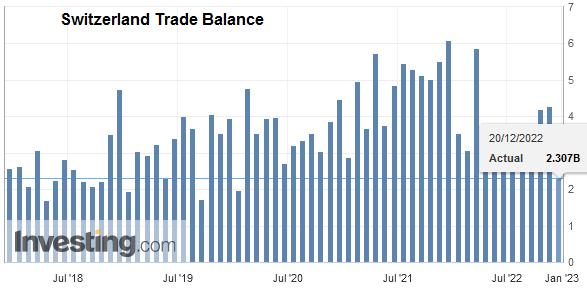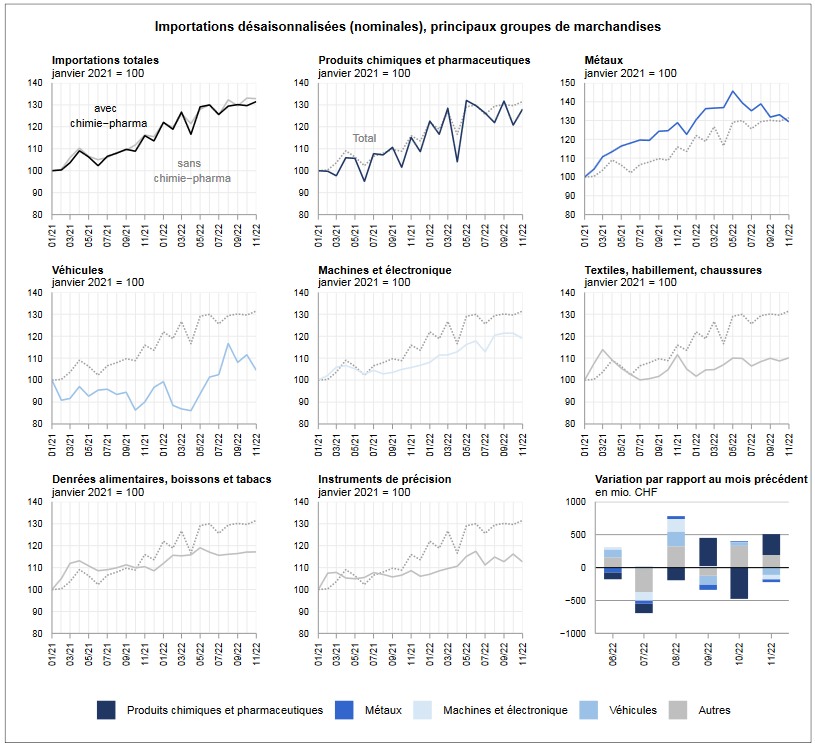We do not like Purchasing Power or Real Effective Exchange Rate (REER) as measurement for currencies. For us, the trade balance decides if a currency is overvalued. Only the trade balance can express productivity gains, while the REER assumes constant productivity in comparison to trade partners. Who has read Michael Pettis, knows that a rising trade surplus may also be caused by a higher savings rate while the trade partners decided to spend more. This is partially true. Recently Europeans started to increase their savings rate, while Americans reduced it. This has led to a rising trade and current surplus for the Europeans. But also to a massive Swiss trade surplus with the United States, that lifted Switzerland on the U.S. currency manipulation watch list. To
Topics:
George Dorgan considers the following as important: 2.) Trade Balance News Service Bunt [FR], 2) Swiss and European Macro, Featured, newsletter, Swiss exports, Switzerland Export, Switzerland Exports, Switzerland Exports by Sector, Switzerland Imports, Switzerland Imports by Sector, Switzerland Trade Balance
This could be interesting, too:
Nachrichten Ticker - www.finanzen.ch writes Die Performance der Kryptowährungen in KW 9: Das hat sich bei Bitcoin, Ether & Co. getan
Nachrichten Ticker - www.finanzen.ch writes Wer verbirgt sich hinter der Ethereum-Technologie?
Martin Hartmann writes Eine Analyse nach den Lehren von Milton Friedman
Marc Chandler writes March 2025 Monthly
We do not like Purchasing Power or Real Effective Exchange Rate (REER) as measurement for currencies. For us, the trade balance decides if a currency is overvalued. Only the trade balance can express productivity gains, while the REER assumes constant productivity in comparison to trade partners.
Who has read Michael Pettis, knows that a rising trade surplus may also be caused by a higher savings rate while the trade partners decided to spend more. This is partially true.
Recently Europeans started to increase their savings rate, while Americans reduced it. This has led to a rising trade and current surplus for the Europeans.
But also to a massive Swiss trade surplus with the United States, that lifted Switzerland on the U.S. currency manipulation watch list.
To control the trade balance against this “savings effect”, economists may look at imports. When imports are rising at the same pace as GDP or consumption, then there is no such “savings effect”.
After the record trade surpluses, the Swiss economy may have turned around: consumption and imports are finally rising more than in 2015 and early 2016. In March the trade surplus got bigger again, still shy of the records in 2016.
Swiss National Bank wants to keep non-profitable sectors alive
Swiss exports are moving more and more toward higher value sectors: away from watches, jewelry and manufacturing towards chemicals and pharmaceuticals. With currency interventions, the SNB is trying to keep sectors alive, that would not survive without interventions.
At the same time, importers keep the currency gains of imported goods and return little to the consumer. This tendency is accentuated by the SNB, that makes the franc weaker.
Texts and Charts from the Swiss customs data release (translated from French).
Exports and Imports YoY DevelopmentIn November 2022, seasonally adjusted exports plunged by almost a tenth while imports increased by 1.4% month on month. At the exit in particular, the chemical-pharmaceutical sector weighed down the result. The trade balance closes with a small surplus of half a billion francs. In short ⇓ Exports fall back to their level at the start of 2022 ⇓ Exports to the USA: –38.7% ⇑ Imports: chemicals-pharmaceuticals and energy products act as locomotives Export trend: ⇒ Import trend:⇒ |
Swiss exports and imports, seasonally adjusted (in bn CHF), November 2022(see more posts on Switzerland Exports, Switzerland Imports, ) |
Global developmentIn November 2022, seasonally adjusted exports fell by 9.2% or CHF 2.1 billion (real: –2.8%), the second biggest monthly setback of the year. At the same time, exports fell back to their January 2022 level, thus showing a flat trend. Conversely, imports increased by 1.4% over one month (actual: −0.6%), reaching a record monthly level. Since mid-2022, however, they have also shown stagnation. As a result of the opposing development of outflow and inflow, the trade balance surplus fell to CHF 494 million, the lowest since January 2018. |
Switzerland Trade Balance, November 2022(see more posts on Switzerland Trade Balance, ) Source: investing.com - Click to enlarge |
Drug exports plunge by a quarterIn November 2022, while two-thirds of the commodity groups were mope, the general decline was due to chemicals and pharmaceuticals. Their exports fell by 19.0% or 2.2 billion francs, weighed down in particular by the fall of a quarter of medicines (−1.2 billion francs). Conversely, sales of active ingredients jumped by 123 million francs over one month. On the winning side, we find watchmaking, the machinery and electronics sector, metals and vehicles, whose cumulative increase reached 158 million francs. From a geographical perspective, the contraction in exports came mainly from North America, more specifically from the USA, which fell by 38.7% (−2.0 billion francs; pharma). Revenue with Asia fell for the third month in a row (−2.7%). Like Singapore, China (−4.3%; fourth decline in a row) suffered. A less gloomy climate characterized Europe (−0.9%). However, the Old Continent recorded contrasting trends, with a jump in shipments to Austria and Germany of almost half a billion francs, while those to Italy contracted by 393 million francs (energy products). |
Swiss Exports per Sector, November 2022(see more posts on Swiss Exports, ) |
Asian imports fall 11% after their record the previous monthOn entry, the majority of commodity groups showed growth. This was mainly supported by chemical and pharmaceutical products, up 318 million francs, in which all the pharma sub-groups shone. Arrivals of energy products increased by 172 million francs (+7.1%; actual: −2.0%) while those of vehicles (−110 million francs; aeronautics) as well as the machinery and electronics sector fell . In the latter, articles and devices from the electrical and electronics industry increased by 146 million francs. The three main supply markets presented heterogeneous evolution. Imports from Europe and North America (USA: +5.1%) increased by 3.6 and 1.1% respectively. Conversely, those in Asia fell 10.7%, after reaching a record level the previous month. In Europe, Austria and Spain gained ground, posting a cumulative increase of 416 million francs (chemicals-pharmaceuticals). On the Asian side, deliveries from China, Singapore and Japan fell by a total of 575 million francs. South Korea, for its part, rose by 109 million francs, after the disappointment of the previous two months. |
Swiss Imports per Sector, November 2022(see more posts on Swiss Imports, ) |
Tags: Featured,newsletter,Swiss Exports,Switzerland Export,Switzerland Exports,Switzerland Exports by Sector,Switzerland Imports,Switzerland Imports by Sector,Switzerland Trade Balance



